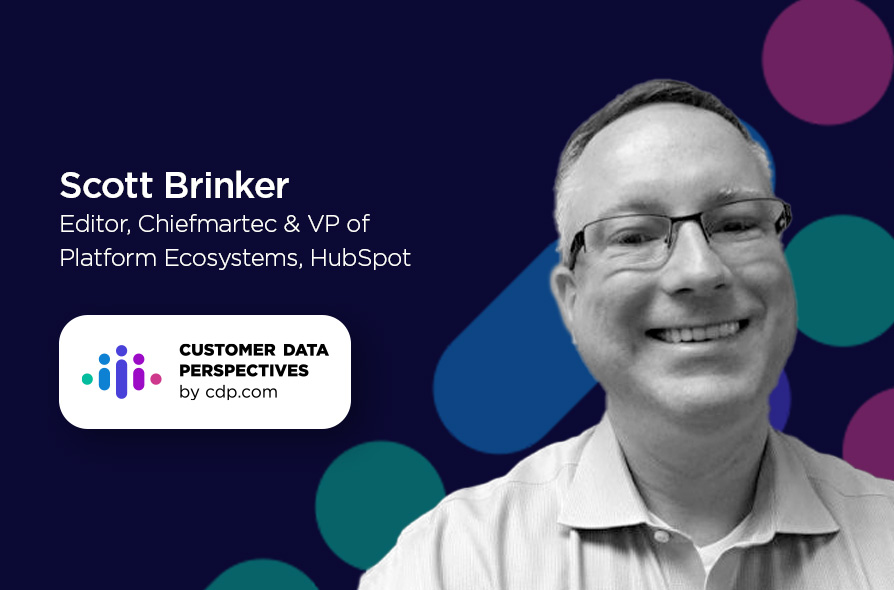“Categories suck, but the only thing that would suck worse than categories is having no categories,” says Scott Brinker, VP of Platform Ecosystems at HubSpot and Editor at chiefmartec.com.
Scott’s remark on categorization is an ironic truism because of the marketing technology landscape he publishes almost yearly. The newest version recently published has nearly 10,000 technologies identified by 49 categories, so Scott knows a thing or two about categorizing marketing technologies and optimizing customer data.
In the latest Customer Data Perspectives podcast episode, I caught up with Scott to discuss marketing technology, customer data, along with best practices for integrating platforms, workflows, and data. You’re in for a real treat listening to Scott about the evolution of digital marketing and how we break down the challenges marketers, data scientists, and technologists have in integrating SaaS tools and centralizing customer data.
MarTech Experimentation is Driven by Customer, Competition, and Technology Evolutions
I decided to expose the elephant in the room right at the start of the episode. Not only are there thousands of technologies to choose from, but the typical enterprise marketing stack also has 120 SaaS technologies and tools used to advertise, nurture prospects, and personalize customer journeys.
The growth even surprised Scott.
“I would’ve never been able to predict the scale at which marketing technology has grown, and pretty much every category keeps going through a renewal,” he said.
Some may accuse marketers of being kids in the candy store looking to try out the latest technologies, but the truth is far from it. The number of technologies available reflects the different data sources, customer segments, activation platforms, and personalization tactics marketers use to optimize their campaigns.
Scott summarizes these drivers: “These three factors are all intertwined. What are the competitors doing? What are customers or consumers expecting because those expectations continue to change? And then, there’s the technology that continues to evolve.”
I added three other factors that are at the forefront for transformation leaders:
- Increases in speed, smartness, and innovation at which companies must transform their business models
- Impacts of changing regulations, especially around data privacy
- Opportunities to improve collaboration between marketers, technologists, and data scientists
So while marketers may have many tools, Scott has one overarching recommendation: “Architecting your tech stack matters.” And as a former CIO, I couldn’t agree more.
Centralizing Customer Data Should Be Job Number One
If the tech stack matters, then where should leaders start bringing order to all the tools, platforms, experiments, and data?
Scott’s answer: “It’s hard for me to imagine a business today that doesn’t need a primary centralized customer data authority. What customer data platform (CDP) do I need?” Scott chuckles before answering, “That’s the harder question to answer.”
Our conversation veers into the technical weeds because customer data is everywhere, and CDPs come in many flavors. In one previous episode of Customer Data Perspectives, David Raab sorted out what a CDP is and why most companies need them. This CDP selection guide suggests reviewing how platforms manage identity resolution, manage cross-channel campaigns, enable machine learning, and ensure data security and privacy.
Reliable, accurate, and timely customer data is needed across the organization, and marketers were one of the first to realize the importance of centralization. Today, customer data is vital to customer support teams, financial service analysts, data scientists, field operations, and just about everyone in the organization who provides direct or indirect customer services.
Scott summarizes the benefits of centralizing customer data like this:
“Marketers have a ton of data that they can now feed to sales, customer success, product ops, finance… and many people who can get value from having that data in the common environment. But marketing is also a huge beneficiary of this because now they’re also able to see data in the other direction, including data about how customers actually use our product.”
Integration of Marketing Tech Drives Experimentation and Collaboration
In the podcast, Scott shares his perspectives on the past and present needs around centralizing customer data. “MarTech spent the past ten years growing up in its own silo because, quite frankly, the rest of the organization wasn’t really ready for it. This whole martech stack got created in a silo disconnected from the rest of the company, and that was probably okay at that stage of what needed to happen then, but today that’s a terrible thing.”
Centralizing customer data is pivotal for marketing organizations that want to experiment with different messaging, activations, and campaigns. But centralizing requires integrations with CRMs, CMS, advertising platforms, marketing automation platforms (MAPs), and any platform where customer data is collected and activations enabled.
“I’m a big advocate for integration,” says Scott. “Ideally, what you want to be able to do is as new technologies emerge, is the ability to experiment with them at relatively low risk.”
Low-code and No-code Accelerate Marketing’s Capabilities
If step one is customer data centralization, and step two is integration, then the third step is empowering the workforce with self-service low-code and no-code capabilities. For example, marketers want to create customer segments, activations, and analytics without needing a technologist or data scientist to develop basic configurations.
Scott explains, “Say I have a question about data. Do I have to get a ticket in the queue for a specialized data analyst to track it down in the data warehouse? Or is there a simplified interface where, for a bunch of questions, I could just go in directly and query it myself?”
The most powerful platforms offer a mix of no-code and low-code capabilities, which cements the collaboration between marketers, technologists, and data scientists to enable ongoing experimentation.
Tune into the podcast where Scott and I break down how we would help marketers with integrations, surprises Scott found in this year’s marketing tech landscape quadrant, and the one easy button Scott wishes for in marketing technologies.



